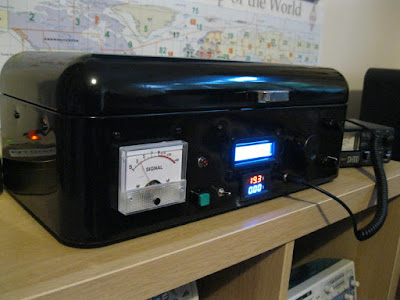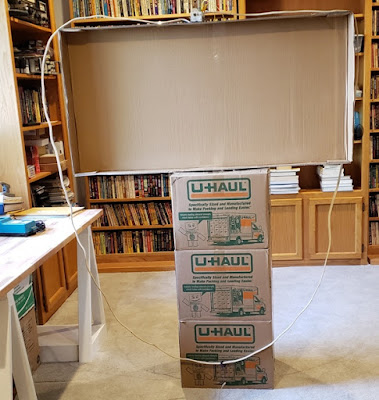Podcasting since 2005! Listen to Latest SolderSmoke
Thursday, May 21, 2020
Replacing Electrolytic Caps in my Drake 2-B (Video)
Every dark cloud has a silver lining. Here is a very small silver lining for this terrible COVID-19 situation: I had time to do a proper replacement of the electrolytic capacitors in my Drake 2-B.
Three cheers for Hayseed Hamfest LLC for providing the replacement capacitor.
Go to their website to find capacitors for many other old rigs:
http://hayseedhamfest.com
Labels:
Drake 2B,
Filters,
Parts suppliers,
Quarantine,
Tubes
Tuesday, May 19, 2020
SolderSmoke on Ham Radio Workbench Podcast
It was great fun talking to George and Jeremy of the Ham Radio Workbench Podcast last week. You can listen to the episode here:
Thanks to George and Jeremy.
Labels:
SolderSmoke Podcast,
web sites
Monday, May 18, 2020
Homebrew Az-El Satellite Antennas from the Philippines and Australia
https://nightskyinfocus.com/2020/05/18/diy-satellite-tracker/
DU1AU is way ahead of where I was when I was working with Low Earth Orbit satellites. I just aimed the antenna about 45 degrees up from the horizon, and spun it around with a TV rotator with me --not the computer -- as the controllers of the rotator. In essence I did the AZ manually and completely ignored the EL. This design moves the antenna in Azimuth and Elevation, and has the computer control the movements via an Arduino. FB.
DU1AU points to the work of VK3FOWL and VK3YSP. Their site has very detailed info on how to build several versions of this kind of Az-El rotator:
https://www.sarcnet.org/rotator-mk1.html
This Az-El project represents a great opportunity to move beyond hand-held satellite antennas, and beyond my Az-only manual approach. It also give us a way to bring some real homebrewing into a part of ham radio that has come to be dominated by commercial equipment. There are some Arduinos and some lines of code, some motors and some metal work. Great stuff!
Labels:
antennas,
Arduino,
Australia,
Philippines,
satellites
Saturday, May 16, 2020
Video on Galaxy V VFO IN USE with BITX40 Module -- 40 meter Bandsweep
Check out that fancy frequency readout. No glowing numerals here. But it does the job.
Labels:
40 meters,
BITX40Module,
Farhan,
Juliano -- Pete,
Quarantine,
VFO
Friday, May 15, 2020
Nick M0NTV's Quarantine Rig: The Bread Bin 80
Hi Bill,
Hope you are keeping well and staying safe.
Just thought I’d let you know about a homebrew project I’ve just completed. I call it the Bread Bin 80 - you’ll see why!
It is a single band (80m) SSB transceiver that puts out 25-30W of clean RF. It uses the familiar pairing of Arduino Uno + Si5351 (with 16x2 LCD screen and rotary encoder for tuning). Other than this though it is largely an analogue beast - which I thought you might like!
I made my own double balanced mixers which work really well. But the Si5351 can’t generate the 7 dBm of local oscillator signal to drive them so I then had to build a simple one transistor RF amp for each clock of the Si5351. I even went above and beyond the call of duty and home-brewed my own IF crystal ladder filter (although this was actually a kit).
The rig has a three stage IF cascade amplifier with 2 back to back JFETs in each stage + AGC and analogue S meter. There is something very satisfying about seeing the needle bob about as you are listening. I also put in a switchable analogue audio filter in front of the audio pre-amp which cuts out some of the higher frequency noise on the band.
Overall I’m really pleased with the rig. I’ve been working stations all over the UK and into continental Europe and getting some great reports. Except the one guy (who shall remain nameless) who wasn’t the least impressed that I was working him on a homebrew rig: he was only keen to point out that my antenna must be far too low to give me such an attenuated signal!!! I guess you can’t please everyone.
Anyway, I’ve done a bit of a write up and included some photos (outside and in) on my QRZ page if you are interested:
Thanks for sharing your home brewing story about your short wave receiver on YouTube. I’ve enjoyed following that and seeing it progress. Those little ‘Altoid’ tins are great aren’t they.
Thanks again for all your encouragement through the Soldersmoke podcast. I really enjoy it.
Stay In The Shack!
Labels:
75 meters,
Quarantine,
Si5351,
UK
Thursday, May 14, 2020
N5GTF's FULLY INDOOR Quarantine Receiver and Antenna
Mike N5GTF deserves special recognition for his truly remarkable SITS (Stay In The Shack) quarantine project. It is not hard to build receivers and transmitters that stay in the shack; Mike went the extra mile by keeping even his antenna inside during lockdown. Well done Mike! But that cardboard frame for the antenna seems to be crying out for some sort of inspirational slogan. Can we get a big "SITS!" in there? 73 Bill
Hi Bill,
Thought I would share a few photos of what happens when one randomly selects things from the junk box after being inspired by Pete's recent posts about phasing SSB. It starts with a 10.7MHz crystal filter because it was large and shiny. This will prove to be somewhat inauspicious, but I'd had a pair of them for longer than I can remember... Then there were several ferrite toroids and a handful of swap meet diodes. Instant mixers, (just add enameled wire). A few 2N3904s and an MC1350P, plus a few more toroids (and wire). I'd picked up some TDA1015s awhile back. They have both a power amp and a preamp, so one of those as well. Also, an Arduino and Si5351, because Charlie Morris, ZL2CTM, has been so generous in sharing his knowledge on how to use them. Finally, about 12 feet of 14/2 w/G and a 365pF variable cap for an indoor mag loop.
Not the best reception though not bad considering the antenna's in the basement with house wiring and metal duct work in the ceiling. The biggest issue is the IF and my choice of LO frequency. I've got the LO below the IF and the LO second harmonic falls inside the 40 meter band. Definitely need to fix that and move on to the transmit side.
Visits to both SolderSmoke and Pete's blog are on my daily agenda. Thanks to you both for the frequent updates of interesting content and for providing a way to get out without going out.
Mike, N5GTF
www.mikesflightdeck.com
Labels:
40 meters,
antennas,
Quarantine,
Si5351
Wednesday, May 13, 2020
Video on the Galaxy V VFO Project
This is the second version of this video. I had some technical difficulties getting it to upload in High Definition, but I was able to work it out in this version.
In this video I describe the VFO project, talk about how I made use of the e-bay Galaxy V parts, talk about the circuit (series-tuned Colpitts), conduct some stability tests, and discuss many of the ways a VFO like this one can be useful to the radio amateur.
Thanks to Pete Juliano for inspiring this effort.
Labels:
Juliano -- Pete,
Old radio,
test gear,
VFO,
video
Tuesday, May 12, 2020
An Understandable Chip: The LM386
Over the years I have made my distaste for integrated circuits very clear. I've presented them as mysterious little black boxes that don't really belong in our homebrew rigs, rigs that we are building, after all, because we want to avoid the use of MYSTERIOUS BLACK BOXES.
So, I don't use voltage regulator chips -- I use Zener diodes. I prefer analog LC oscillators to AD9850s or Si5351s. And I have repeatedly built discrete component audio amplifiers when most normal people just put an IC AF amplifier in the circuit.
When I built the Q-31 Shortwave AM receiver, I kind of ran out of gas at the end. I wanted to get the receiver going and I didn't want to build yet another discrete AF amp. So I used an LM386.
I rationalized this deviation from cherished values by noting that the discrete AF amplifier circuitry that I was using was remarkably similar to what exists inside the LM386. So that little chip is just as understandable as my discrete component creations. It wasn't REALLY a mysterious black box...
Around this time I found a web site that made me feel mush better about all this. It explains very nicely how the little LM386 does such a great job. It really packs a lot of amplification into a very small package. Here is the web site:
https://www.electrosmash.com/lm386-analysis
Shortly after my transgression, Jenny List over at Hack-A-Day posted a nice piece looking at the inner workings of Op-Amps. Who knows, I may seen be using 741 chips too!
Here is the Hack-A-Day piece:
https://hackaday.com/2020/05/09/an-op-amp-from-the-ground-up/
Labels:
audio amplifiers,
integrated circuits,
Si5351
Saturday, May 9, 2020
Bill Meara Graduates with Honors from James Madison University
| Deep thoughts where Faraday lectured |
He has been part of the podcast and blog since the beginning: Camera kites, video rockets and crystal radios. Drones and exploding corn starch. The Trivial Electric Motor. Visits to Faraday's lab and Marconi's house. Billy helped me wind toroids at age 2!. He went with me to hamfests in Virginia and in London.
Here are just some of the blog posts in which Billy is a key player: https://soldersmoke.blogspot.com/search?q=Billy
This video demonstrates Billy's early interest in biotechnology:
This video demonstrates Billy's early interest in biotechnology:
And of course, he is the guy who says "Ooo! That's awesome" in all of the podcasts.
Yesterday was a big day: We are very proud of our son Bill Meara who graduated with honors yesterday from James Madison University. Bill earned his Bachelor of Science degree in Biotechnology. In a few weeks he will be heading to Boston where he will start work at a neuroscience research lab of Harvard University.
 |
| 2020 Virtual Graduation |
 |
| Billy's mom, sister and dad watching the graduation |
Graduation: Oooo! That's Awesome!
Labels:
Billy
Tuesday, May 5, 2020
Subscribe to:
Posts (Atom)
































